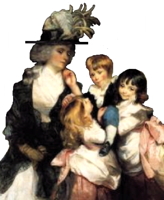
|
The Society of Folk Dance Historians (SFDH) Teaching Children
[
Home |
About |
Encyclopedia | CLICK AN IMAGE TO ENLARGE |

|
I am going to be running a Renaissance dancing class for primary school children – ages 5 to 12. I am looking for suggestions about what dances others have had success with in this age group. I am hoping that the group may also be able to put on a display a the end of term next year – so am looking for sources for costume patterns and ideas.
Warmest Regards
–Aylwen Garden
Bransles are the best, especially pantomine bransles. Reluctant dancers can be encouraged by presenting it more as a game than a dance, emphasising imitative aspects, rather than the dance steps. Avoid any suggestion that dances are supposed to be romantic. Let children of the same gender be partners if taking hands with girls becomes an obstacle. Some of the 15th circa Italian dances that are essentially "follow the leader" (like Petit Vriens) can work well with children. Again, don't fuss over step styling. You may have individual children who have the dance background to learn more complex dances for a presentation. (There are children in my area who can do clogging routines that would put many canary variations to shame.) I don't know if they are available in Australia, but Simplicity has been adding quite a few good-looking Renaissance patterns to the costume section of their pattern line.
Good luck with your class!
–Mary Railing
When I taught kindergarteners and first graders, I told them that I was going to teach a square dance and then taught them Quadran Pavane. They "got" the joke without explanation and this was a big hit. Little ones also love the bounciness of Pease Bransle, especially when they are told that they are imitating boiling peas in a pot. Actually, most any Bransle will do with the little ones, except probably for the War Bransle, of course. The older children, the fourth through sixth graders, will most likely be willing to do nearly anything energetic, as long as it isn't too complicated. What I mostly remember about teaching children this age is lots of energy and a desire to learn as much dance as possible. It's probably a good idea to have several extra dances prepared to teach just in case. I'd also suggest trying to find out if they've had any dance in gym or whatever. If they've had some experience learning how to dance, they could easily surprise you with how much they can learn in a short time. I taught sixth graders who had dancing experience, by the way, Jouissance Vous Donnerez for a holiday program. The teacher and the students were willing to do the necessary extra work when I wasn't around (I made lots of copies of the choreography and everyone had a little tape of the music to take home). They ended up doing a really good job. Sorry, I can't help with garb ideas . . . I've found that the energy and enthusiasm of children makes teaching them a lot of fun. I hope you find this to be true, as well.
Good luck!
DOCUMENTS
- Renaissance, a culture.
- Teaching Children to Folk Dance, an article.
This page © 2018 by Ron Houston.
Please do not copy any part of this page without including this copyright notice.
Please do not copy small portions out of context.
Please do not copy large portions without permission from